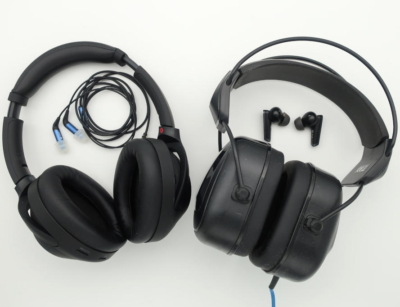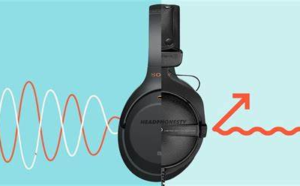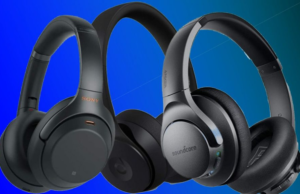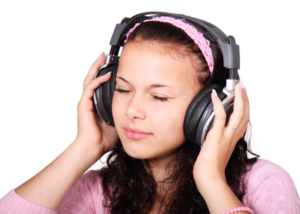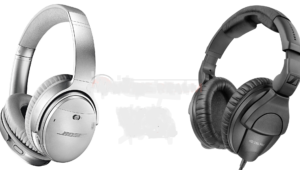In the realm of audio technology, “Noise Cancelling vs Noise Isolating” has become a subject of significant intrigue, and for good reason. As individuals seek respite from the cacophony of modern life, they often find themselves at a crossroads when choosing between these two distinct approaches to achieving a quieter, more immersive auditory experience.
Noise cancelling and noise isolating headphones are both designed to reduce the amount of ambient noise that reaches your ears. Noise cancelling headphones use active noise cancellation (ANC) to reduce noise. ANC works by emitting a sound wave that is the exact opposite of the ambient noise.
Moreover, noise isolating headphones, on the other hand, use passive noise reduction to block out noise. They do this by creating a tight seal around your ears, which prevents sound waves from entering.
Noise cancelling headphones are generally more effective at reducing noise than noise isolating headphones, especially when it comes to low-frequency noise, such as the rumble of an airplane engine. However, noise cancelling headphones can be more expensive than noise isolating headphones, and they may require batteries to operate.
What is the primary goal of noise-canceling technology?
The primary goal of noise-canceling technology is to reduce or eliminate unwanted noise. This can be done for a variety of reasons, including:
- To improve the listening experience. Noise-canceling headphones can be used to listen to music, podcasts, or audiobooks in noisy environments, such as on an airplane or in a busy coffee shop.
- To reduce distractions. Noise-canceling headphones can also be used to reduce distractions in work or study environments.
- To improve communication. Noise-canceling headsets can be used to improve communication quality in noisy environments, such as call centers or customer service centers.
- To protect hearing. Noise-canceling earplugs can be used to protect hearing from loud noise, such as in industrial settings or at concerts.
Noise-canceling technology works by creating an anti-noise signal that is equal in amplitude and opposite in phase to the unwanted noise. This anti-noise signal is then combined with the original sound signal, which cancels out the unwanted noise.
More so, noise-canceling technology is used in a variety of products, including headphones, headsets, earplugs, and active noise control systems. Active noise control systems are used to reduce noise in large spaces, such as aircraft cabins, offices, and factories.
How do noise-canceling headphones work?
Noise-canceling headphones work by using a combination of microphones and speakers to create an anti-noise signal.
The microphones pick up ambient noise, and the speakers emit an anti-noise signal that is equal in amplitude and opposite in phase to the ambient noise. This anti-noise signal cancels out the ambient noise, resulting in a quieter listening experience.
Here is a more detailed explanation of how noise-canceling headphones work:
- The microphones in the headphones pick up the ambient noise around you.
- The headphones then analyze the ambient noise to determine its frequency and amplitude.
- The headphones then generate an anti-noise signal that is equal in amplitude and opposite in phase to the ambient noise.
- The anti-noise signal is then played through the speakers in the headphones.
- When the anti-noise signal and the ambient noise meet, they cancel each other out, resulting in a quieter listening experience.
Furthermore, noise-canceling headphones are most effective at canceling out low-frequency noise, such as the rumble of an airplane engine or the hum of a coffee shop. They are less effective at canceling out high-frequency noise, such as human voices or the sound of traffic.
Noise-canceling headphones are a popular choice for travelers, students, and people who work in noisy environments. They can help to improve the listening experience, reduce distractions, and protect hearing.
In contrast, what is the primary purpose of noise-isolating headphones?
Noise-isolating headphones are designed to reduce noise by creating a physical barrier between your ear and the outside world. This is done by using ear cups or eartips that create a tight seal around your ears.
Also, noise-isolating headphones are most effective at blocking out high-frequency noise, such as human voices or the sound of traffic. They are less effective at blocking out low-frequency noise, such as the rumble of an airplane engine or the hum of a coffee shop.
Noise-isolating headphones are a good choice for people who want to reduce noise without having to use batteries or other power sources. They are also a good choice for people who need to block out high-frequency noise, such as musicians or people who work in noisy environments.
Here are some of the benefits of using noise-isolating headphones:
- Reduced noise levels: Noise-isolating headphones can help to reduce the overall noise level that you are exposed to.
- Improved listening experience: Noise-isolating headphones can help you to hear music, podcasts, and audiobooks more clearly in noisy environments.
- Reduced distractions: Noise-isolating headphones can help you to focus on your work or studies by reducing distractions from ambient noise.
- Protected hearing: Noise-isolating headphones can help to protect your hearing from loud noise by reducing the overall volume of the noise that you are exposed to.
If you are looking for a way to reduce noise without having to use batteries or other power sources, noise-isolating headphones are a good option. They are also a good choice for people who need to block out high-frequency noise, such as musicians or people who work in noisy environments.
Explain the mechanism of noise isolation
Noise isolation is a method of noise reduction that uses physical barriers to block out noise. This is done by using ear cups or eartips that create a tight seal around your ears. The seal prevents sound waves from entering your ears, thereby reducing the overall noise level that you are exposed to.
Also, Noise isolation is most effective at blocking out high-frequency noise, such as human voices or the sound of traffic. This is because high-frequency sound waves have shorter wavelengths and are therefore easier to block.
Low-frequency sound waves, such as the rumble of an airplane engine or the hum of a coffee shop, have longer wavelengths and are more difficult to block.
However, even noise-isolating headphones can block out some low-frequency noise. The amount of low-frequency noise that is blocked will depend on the quality of the headphones and the fit.
Noise isolation is a passive method of noise reduction. This means that it does not require any external power source. This makes noise-isolating headphones a good choice for people who need to reduce noise but do not want to use batteries.
Here is a more detailed explanation of the mechanism of noise isolation:
- Sound waves enter the ear canal and travel to the eardrum.
- The eardrum vibrates in response to the sound waves.
- The vibrations from the eardrum are transmitted to the inner ear through the ossicles (three small bones).
- The inner ear converts the vibrations into electrical signals that are sent to the brain.
- The brain interprets the electrical signals as sound.
Noise-isolating headphones work by blocking the sound waves from entering the ear canal. This is done by creating a tight seal around the ears. The seal prevents the sound waves from reaching the eardrum.
Which type of headphones is more effective in reducing external sounds: noise-canceling or noise-isolating?
Noise-canceling headphones and noise-isolating headphones are designed to reduce external sounds, but they employ different methods to achieve this, and their effectiveness can vary based on the type and level of noise you’re trying to block out.
-
Noise-Canceling Headphones:
- Effectiveness: Noise-canceling headphones are highly effective at reducing external sounds, especially continuous, low-frequency noise like the hum of airplane engines, the drone of a train, or air conditioning systems. They excel at canceling out these types of noises, making them ideal for travelers.
- Active Technology: They use active noise cancellation (ANC) technology, which means they have built-in microphones that pick up external sounds and generate sound waves to cancel out those sounds. This process is particularly effective for constant background noise.
- Limitations: Noise-canceling headphones may not be as effective at blocking sudden, sharp sounds, such as a sudden loud conversation or a door slamming, as they’re more focused on continuous sounds.
-
Noise-Isolating Headphones:
- Effectiveness: Noise-isolating headphones are effective at reducing external sounds by physically blocking them through the design of the earcups and the use of passive sound-isolation materials (e.g., foam or rubber ear tips). They can be very effective at blocking high-frequency noises, like chatter, office noise, and traffic.
- Passive Technology: Noise-isolating headphones do not rely on active technology but rather the physical design and materials to create a seal that reduces external sounds. This means they can be effective at blocking both continuous and sudden noises.
- Limitations: Noise-isolating headphones may not be as effective as noise-canceling headphones at reducing low-frequency sounds like airplane engine noise.
The choice between noise-canceling and noise-isolating headphones depends on your specific needs and preferences. If you frequently find yourself in noisy environments with consistent low-frequency noise, noise-canceling headphones are likely more effective.
On the other hand, if you need general noise reduction for various situations and prefer a more natural sound experience, noise-isolating headphones can be a suitable choice.
What are the key benefits of noise-canceling headphones?
Noise-canceling headphones offer several key benefits that make them a popular choice for many individuals seeking an enhanced listening experience and relief from external noise:
- Active Noise Cancellation (ANC): The primary benefit of noise-canceling headphones is their ability to actively reduce or eliminate unwanted external sounds. ANC technology uses built-in microphones to detect environmental noise and then generates sound waves that are 180 degrees out of phase with the detected noise, effectively canceling it out. This allows you to enjoy your music or audio content in a quieter, more immersive environment.
- Improved Sound Quality: By reducing or eliminating background noise, noise-canceling headphones can significantly enhance the clarity and quality of the audio you’re listening to. You can hear more detail in your music, podcasts, or other content, even in noisy settings.
- Reduced Listening Fatigue: With noise-canceling headphones, you don’t need to turn up the volume to drown out external noise. This means you can listen at lower, safer volumes, reducing the risk of hearing damage and listening fatigue.
- Enhanced Concentration: Noise-canceling headphones are excellent for concentration, whether you’re working in a noisy office, studying in a busy cafe, or simply trying to focus in a noisy environment. They create a quieter space for you to concentrate without distraction.
- Travel Comfort: These headphones are especially popular among travelers. They can make long flights or commutes more comfortable by reducing the drone of engines, chatter, and other ambient noises.
- Customizable Sound: Many noise-canceling headphones come with apps that allow you to customize the level of noise cancellation, so you can adjust it to your preferences and the situation.
- Versatility: Noise-canceling headphones are versatile and can be used in a wide range of scenarios, from work and travel to leisure and relaxation. Some models also have a transparency mode that allows you to hear your surroundings when needed.
- Improved Sleep: Some people use noise-canceling headphones to help them sleep by blocking out ambient noise, especially if they live in noisy urban environments or have trouble sleeping due to disturbances.
While noise-canceling headphones offer these benefits, it’s important to note that they can be more expensive than regular headphones and may require a power source (usually a rechargeable battery) to operate the noise-canceling feature.
What are the key benefits of noise-isolating headphones?
The key benefits of noise-isolating headphones include:
- Reduced noise levels: Noise-isolating headphones can help to reduce the overall noise level that you are exposed to. This is because they create a physical barrier between your ear and the outside world, which prevents sound waves from entering your ear canal.
- Improved listening experience: Noise-isolating headphones can help you to hear music, podcasts, and audiobooks more clearly in noisy environments. This is because they reduce ambient noise, which can mask the sounds that you are trying to hear.
- Reduced distractions: Noise-isolating headphones can also help you to focus on your work or studies by reducing distractions from ambient noise. This can be especially helpful if you work in a noisy environment, such as an office or a coffee shop.
- Protected hearing: Noise-isolating headphones can help to protect your hearing from loud noise by reducing the overall volume of the noise that you are exposed to. This can be especially helpful if you travel frequently or work in a noisy environment.
- Affordability: Noise-isolating headphones are generally more affordable than noise-canceling headphones.
- Portability: Noise-isolating headphones are often smaller and lighter than noise-canceling headphones, making them more portable.
- No batteries required: Noise-isolating headphones do not require batteries to operate, unlike noise-canceling headphones.
- Comfort: Noise-isolating headphones can be more comfortable to wear for long periods of time than noise-canceling headphones, especially for people with glasses.
Overall, noise-isolating headphones offer a number of key benefits that can improve your quality of life. If you are looking for a way to reduce noise levels, improve your listening experience, reduce distractions, and protect your hearing, then noise-isolating headphones are a great option.
Can noise-isolating headphones completely block out all external noise?
Noise-isolating headphones cannot completely block out all external noise. They can reduce noise levels significantly, but some noise will still be audible. This is because noise-isolating headphones work by creating a physical barrier between your ear and the outside world, but they cannot completely seal off the ear canal.
The amount of noise that is blocked by noise-isolating headphones will depend on a number of factors, including:
- The quality of the headphones
- The fit of the headphones
- The type of noise that you are trying to block out
Noise-isolating headphones are most effective at blocking out high-frequency noise, such as human voices or the sound of traffic. They are less effective at blocking out low-frequency noise, such as the rumble of an airplane engine or the hum of a coffee shop.
If you need to block out a lot of noise, even low-frequency noise, then noise-canceling headphones are the best option. Noise-canceling headphones use a combination of microphones and speakers to create an anti-noise signal that cancels out ambient noise.
However, even noise-canceling headphones cannot completely block out all external noise. Some noise will still be audible, especially in very noisy environments.
Do noise-canceling headphones require a power source to function?
Noise-canceling headphones require a power source to function. The active noise cancellation feature on noise-canceling headphones uses a combination of microphones and speakers to create an anti-noise signal that cancels out ambient noise. This process requires power, which is typically supplied by a battery or a USB port.
Most noise-canceling headphones have a built-in rechargeable battery. The battery life of noise-canceling headphones varies depending on the model and the volume level at which you are listening to music. Most noise-canceling headphones can provide around 20-30 hours of battery life on a single charge.
Some noise-canceling headphones also have a wired mode, which allows you to use them without the active noise cancellation feature. This can be useful if you run out of battery or if you are in an environment where you do not need noise cancellation.
If you are looking for noise-canceling headphones, be sure to choose a model that has a long battery life and a wired mode as well. This will ensure that you can continue to use your headphones even if you run out of battery or if you are in an environment where you do not need noise cancellation.
How do noise-isolating headphones create a seal in the ear?
Noise-isolating headphones create a seal in the ear using a variety of methods, including:
- Ear cups: Noise-isolating headphones typically have large ear cups that fit snugly over the ears. This helps to create a physical barrier between the ear and the outside world.
- Eartips: Many noise-isolating headphones also come with eartips that are inserted into the ear canal. The eartips create a tight seal that prevents sound waves from entering the ear.
- Foam: Some noise-isolating headphones use foam ear cups or eartips to create a seal. The foam expands to fill the ear canal or the ear cup, creating a tight fit.
The type of seal that is used in noise-isolating headphones will vary depending on the model of the headphones. However, all noise-isolating headphones use some form of seal to create a physical barrier between the ear and the outside world.
What are some common use cases for noise-canceling headphones?
Noise-canceling headphones are a popular choice for a variety of use cases, including:
- Travel: Noise-canceling headphones can help to reduce the noise of airplanes, trains, and buses, making travel more comfortable and relaxing.
- Work: Noise-canceling headphones can help to reduce distractions in noisy workplaces, such as open-plan offices or call centers.
- Study: Noise-canceling headphones can help to reduce distractions in study environments, such as libraries or coffee shops.
- Commute: Noise-canceling headphones can help to reduce the noise of traffic and other distractions on your commute.
- Sleep: Noise-canceling headphones can help to block out noise that can interfere with sleep.
- Entertainment: Noise-canceling headphones can help to improve the sound quality of music, movies, and TV shows.
- Gaming: Noise-canceling headphones can help to create a more immersive gaming experience by blocking out ambient noise.
When might noise-isolating headphones be more suitable than noise-canceling ones?
Noise-isolating headphones may be more suitable than noise-canceling ones in the following situations:
- When you need to be aware of your surroundings. Noise-canceling headphones can block out a lot of noise, which can be dangerous in some situations, such as when walking or biking in traffic. Noise-isolating headphones still block out some noise, but they allow you to hear more of the ambient noise around you.
- When you need a more affordable option. Noise-isolating headphones are generally less expensive than noise-canceling headphones.
- When you need a more portable option. Noise-isolating headphones are often smaller and lighter than noise-canceling headphones, making them easier to carry with you.
- When you don’t need to block out low-frequency noise. Noise-isolating headphones are more effective at blocking out high-frequency noise, such as human voices or the sound of traffic. They are less effective at blocking out low-frequency noise, such as the rumble of an airplane engine or the hum of a coffee shop. If you don’t need to block out low-frequency noise, then noise-isolating headphones may be a good option for you.
Are there any disadvantages to using noise-canceling headphones?
There are some disadvantages to using noise-canceling headphones, including:
- Cost: Noise-canceling headphones are generally more expensive than regular headphones.
- Battery life: Noise-canceling headphones require battery power to operate, so you will need to keep them charged if you want to use the noise-canceling feature.
- Reduced awareness of surroundings: Noise-canceling headphones can block out a lot of noise, which can be dangerous in some situations, such as when walking or biking in traffic.
- Pressure in the ears: Some people may experience pressure in their ears when using noise-canceling headphones for long periods of time.
- Reduced sound quality: Noise-canceling headphones can sometimes reduce the sound quality of music or other audio content.
It is vital to weigh the advantages and disadvantages of noise-canceling headphones before deciding whether or not to purchase them. If you need to block out a lot of noise and are willing to pay a premium for the convenience, then noise-canceling headphones may be a good option for you.
What factors should you consider when choosing between noise-canceling and noise-isolating headphones?
When choosing between noise-canceling and noise-isolating headphones, there are a few factors you should consider:
- Budget: Noise-canceling headphones are generally more expensive than noise-isolating headphones.
- Noise reduction: Noise-canceling headphones are more effective at blocking out low-frequency noise, such as the rumble of an airplane engine or the hum of a coffee shop. Noise-isolating headphones are more effective at blocking out high-frequency noise, such as human voices or the sound of traffic.
- Comfort: Noise-canceling headphones can be heavier and bulkier than noise-isolating headphones.
- Portability: Noise-isolating headphones are often smaller and lighter than noise-canceling headphones, making them easier to carry with you.
- Battery life: Noise-canceling headphones require battery power to operate while noise-isolating headphones do not.
- Sound quality: Noise-canceling headphones can sometimes reduce the sound quality of music or other audio content.
Can you use noise-canceling and noise-isolating headphones together for even better noise reduction?
You can use noise-canceling and noise-isolating headphones together for even better noise reduction. This is known as “active and passive noise cancellation.”
Noise-canceling headphones use microphones to detect ambient noise and then create an anti-noise signal to cancel it out. Noise-isolating headphones, on the other hand, create a physical barrier between your ears and the outside world, which prevents sound waves from entering your ear canals.
When you use noise-canceling and noise-isolating headphones together, you can achieve a significant reduction in both low-frequency and high-frequency noise. This can be especially beneficial in noisy environments, such as airplanes, trains, and busy city streets.
However, it is important to note that using noise-canceling and noise-isolating headphones together can also reduce your awareness of your surroundings. This can be dangerous in some situations, such as when walking or biking in traffic.
Here are some tips for using noise-canceling and noise-isolating headphones together safely:
- Only use noise-canceling and noise-isolating headphones in situations where it is safe to do so. For example, avoid using them when walking or biking in traffic.
- Be aware of your surroundings, even when you are using noise-canceling and noise-isolating headphones. If you need to be able to hear ambient noise, such as car horns or sirens, turn off the noise-canceling feature.
- Take breaks from using noise-canceling and noise-isolating headphones. This will help to prevent hearing damage and reduce pressure in your ears.
Overall, using noise-canceling and noise-isolating headphones together can be a great way to reduce noise and improve your listening experience.
Conclusion
Noise Cancelling vs Noise Isolating: Noise-canceling and noise-isolating headphones are both effective at reducing noise, but they work in different ways. Noise-canceling headphones use microphones to detect ambient noise and then create an anti-noise signal to cancel it out.
Noise-isolating headphones, on the other hand, create a physical barrier between your ears and the outside world, which prevents sound waves from entering your ear canals.
Moreover, noise-canceling headphones are more effective at reducing low-frequency noise, such as the rumble of an airplane engine or the hum of a coffee shop. Noise-isolating headphones are more effective at reducing high-frequency noise, such as human voices or the sound of traffic.

